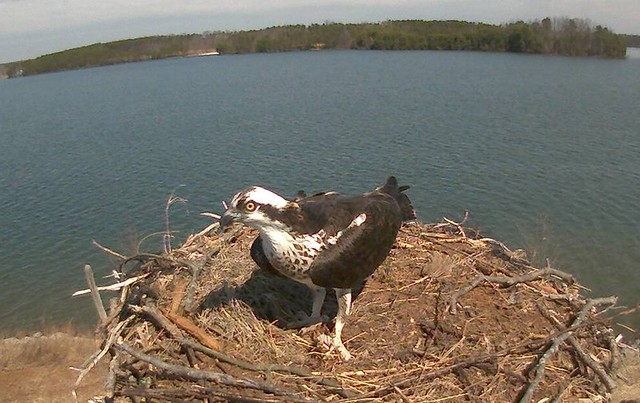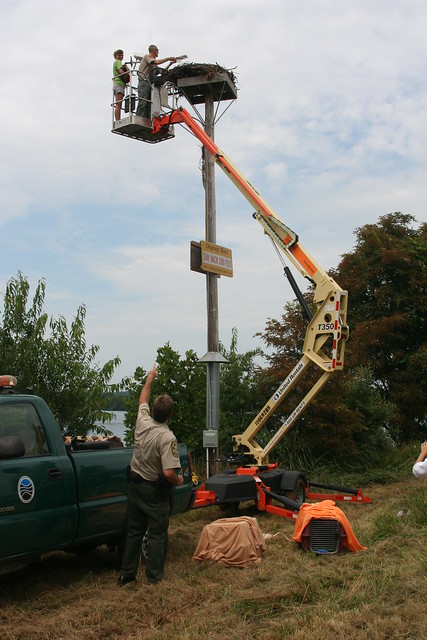Good news! One of the early signs of spring is the return of the ospreys. This article is the first in a series of six. Keep an eye out for new installments weekly, brought to you by the Watch the nest live!

The osprey has returned to nest at Smith Mountain Lake State Park
First sighting for 2014
On Saturday, Mar 5, 2014, our State Park Interpreter, Jeanette Lawler saw a female osprey land on the nest at the park. They left the lake last September and spent the winter on the coast of South America or the Caribbean Islands. They are returning because the waters of the lake are warming up, and the fish are coming to the surface. Since the osprey’s diet is almost exclusively live fish, their habitat would be near water, seacoasts, rivers and lakes. Smith Mountain Lake (SML) is an ideal location for ospreys because it is a large body of water with an abundance of fish.
How the osprey cam came to be
In 2003 former park Interpreter, and current member of the SML State Park and a pole and platform were constructed near the R-16 channel marker on the lake’s “S-curve” of the Roanoke River Channel, behind the Discovery Center. It was completed in time for the 2004 nesting season, and was equipped with a live feed video camera above the nest. Since that time many broods have been successfully raised. Last year 2 ospreys fledged.

All about the ospreys
Now that the birds are returning to the lake, the female decides where the nest site will be located. Ospreys prefer structures over or near the water. They are well known for their nesting sites on power poles, channel markers, even bill boards. There is a famous pair of osprey in Florida who attempted to build a nest atop a boom of a temporarily idle construction crane. The owner, to his credit, retired the crane so the osprey could follow through with their nest building efforts.
Back at the lake, the female ospreys have probably returned to the nests they left last year and are about a week ahead of the males. When he arrives, she will begin a begging call for food. In the mean time the male will be trying to attract the attention of the female by flying in a slow roller coaster pattern sometimes carrying a stick or a fish. What really matters to the female is the male’s ability to provide food to her and her brood. An established mate will usually respond, or a new suitor will take over. Usually the female does not look for other suitors if the male has brought plenty of food in the past. Generally, the ospreys mate for life.
Now the real work begins by building or adding to the existing nest. They both will build the nest but the female has a larger role. When building the nest, the osprey not only uses twigs and branches, but also uses junk and litter. For example, they have used, Styrofoam cups, buoys, fishing nets and tackle, plastic rings for a six-pack of cans, and ground cloth. This is a good reason to be mindful to properly dispose of your litter and trash. This type of junk can be very hazardous to the birds. Osprey nests have been known to be in use for 40-45 years and can weigh up to 400 pounds, because the nests get passed down through generations. Once the nest is built, breeding and egg laying begin. The first egg should appear in early April.
Click here for a link to the live stream.
Thanks to the park.
